The proverb “Necessity is the mother of invention” is credited to philosophers going back to Plato. But a modern paraphrase claims that boredom is another mother of invention. It certainly was for me in 2018, when my wife and I took a bus tour of Newfoundland.
To be Clear
Actually, this Canadian island is anything but boring! It is spectacularly gorgeous, endlessly fascinating, and enjoys perhaps the most welcoming people we’ve ever met. Also, St. John’s (its lively sea-side capital) is totally “happening”… especially on a warm Friday evening!
But, to tour Newfoundland by car or bus, one spends a lot of time on the province’s 900-ish miles of Trans-Canada Highway. It’s mostly a narrow two-lane road through endless stands of beautiful forest… with occasional rocky outcroppings and exits to coastal towns with names like Blow me Down, Come by Chance, Cow Head, George’s Point, Knights Cove, Muddy Hole, Tickle (Cove or Harbor), Tilting, Virgin Cove and Woody Point!
It was my first major outing with a new Panasonic Lumix ZS100 compact point-and-shoot. It boasts a 1-inch, 20-megapixel sensor behind a 10x stabilized Leica zoom. But I quickly grew bored with all the gorgeous green that passed outside our bus on long Trans-Can stretches, and decided to muck around with something called the “Rolling-Shutter Effect.” For many photographers, it’s a nuisance. But I chose to take the photographic road less traveled and use it to shoot some interesting images from inside our bus.
“Rolling Shutter” vs “Shutter Drag”
“Rolling Shutter” isn’t the same thing as what’s currently called “Shutter Drag.” The latter involves taking long existing-light exposures of moving subjects, followed by a pop of flash to freeze them into sharp focus. (Think of all the shots you’ve seen of dancers spinning and moving within swirling clouds of their own arms, legs and costumes.) The effect can be created in many ways, doesn’t actually involve “dragging” shutters, and might perhaps be achieved fairly easily using a modern camera’s Night Portrait mode.
The Rolling-Shutter Effect, however, was first seen in film cameras whose focal-plane shutters didn’t expose entire negatives all at once– but instead, through a narrow slit that flashed across the film. For example, you may have seen an old photo like this– of a race car slanted as if by speed, on tires that are oval rather than round:
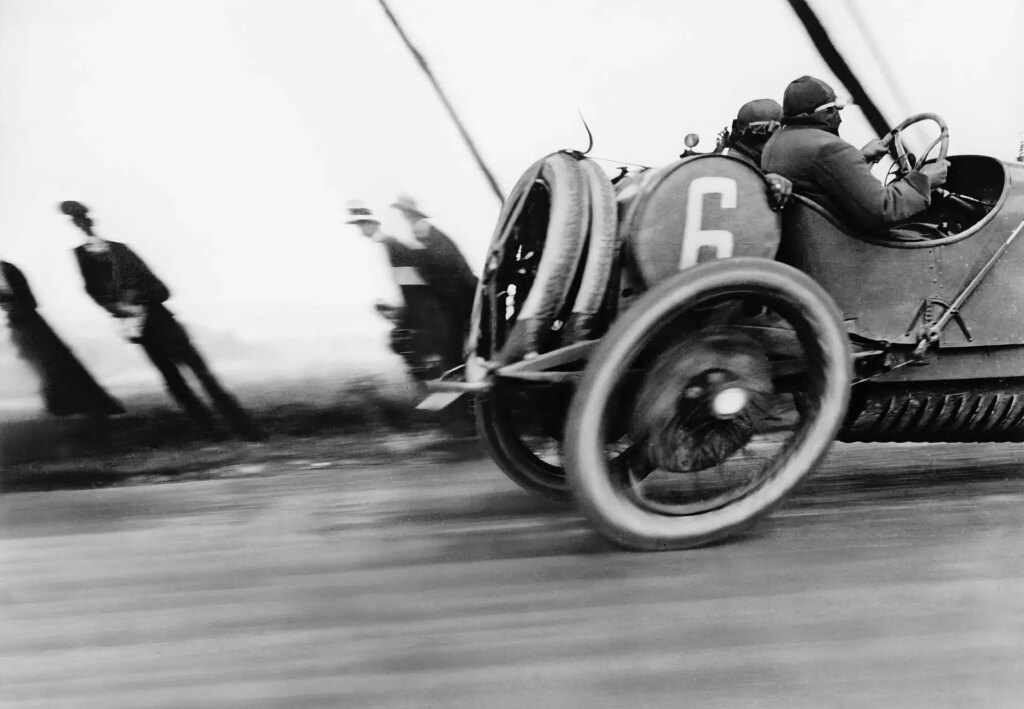
As the car passed Lartigue’s camera, its focal-plane shutter captured thin horizontal slices of the vehicle at progressive locations along the road. The car would appear to lean forward or backward depending on whether the shutter slit moved down or up across the film. And people in Lartigue’s photo lean the opposite direction because he also panned his camera to track the car. [The shutter of Lartigue’s camera appears to have moved from the observers’ feet to their heads as he panned– or (since camera lenses invert the outside world) the shutter slit seems to have exposed the negative from the top to the bottom of the camera.]
The same thing occurs in many film rangefinders, SLRs, and digital cameras. (Most notably, it’s why rotating propellers look bent and broken in digital movies.) CMOS models like my ZS100 may expose their entire sensor to light, but they load its pixel data into memory line-by-line for processing. This can produce the Rolling-Shutter Effect. (CCD sensors, however, are called “global sensors” because they read, process and store all image data at one time… and don’t exhibit the effect.)
Many websites offer advice about avoiding, minimizing or correcting Rolling Shutter. But on the Trans-Can in Newfoundland, while rolling through endless forests, I decided to play with it.
Starting Small
First, an apparently hand-retouched exit-ramp sign:
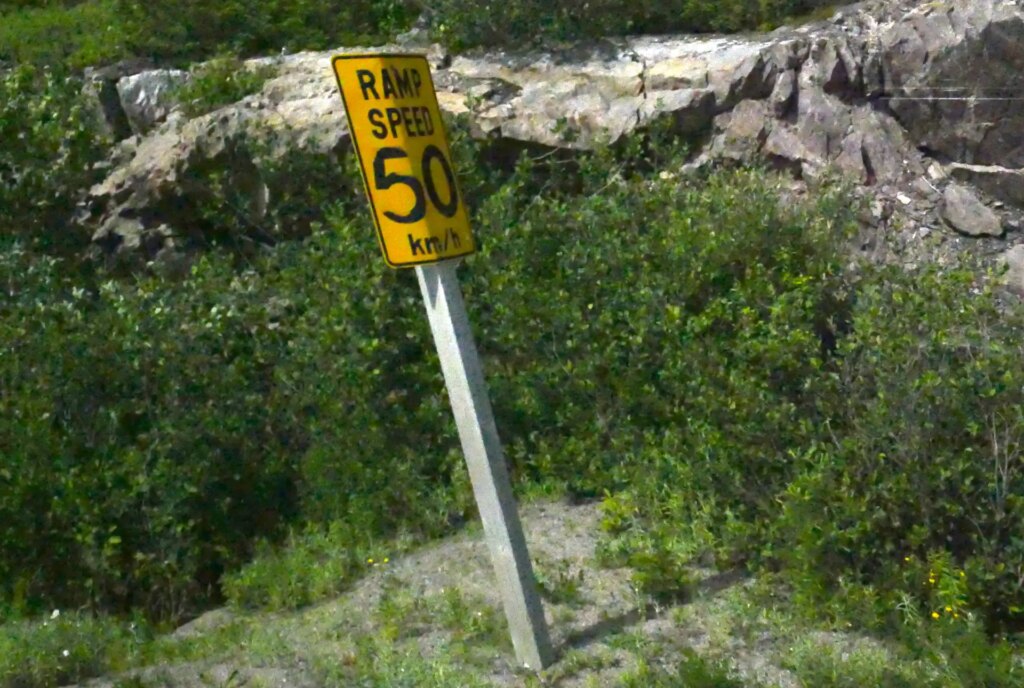
And a bigger sign:

Then a typical Trans-Can scenic (where the trees weren’t really leaning):
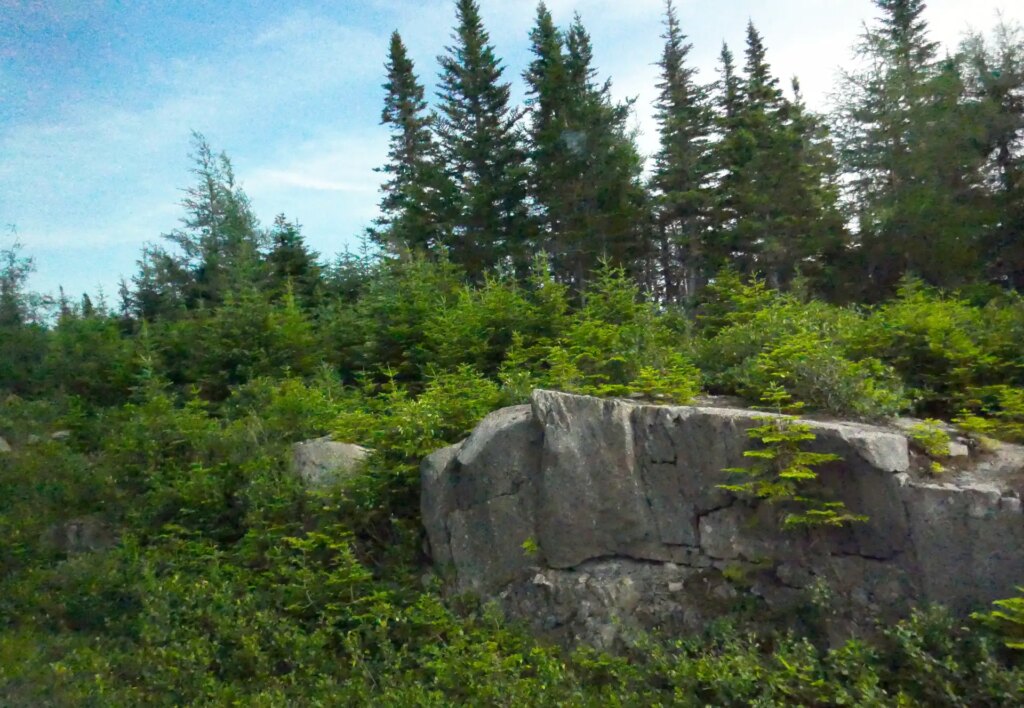
And a “passing” shack:

Going for More Slant
But due to perspective, light from things in the middle-to-far distance didn’t move across the ZS100 sensor fast enough to really slant. So I went after closer game: vehicles whizzing by in the lane just outside my window:
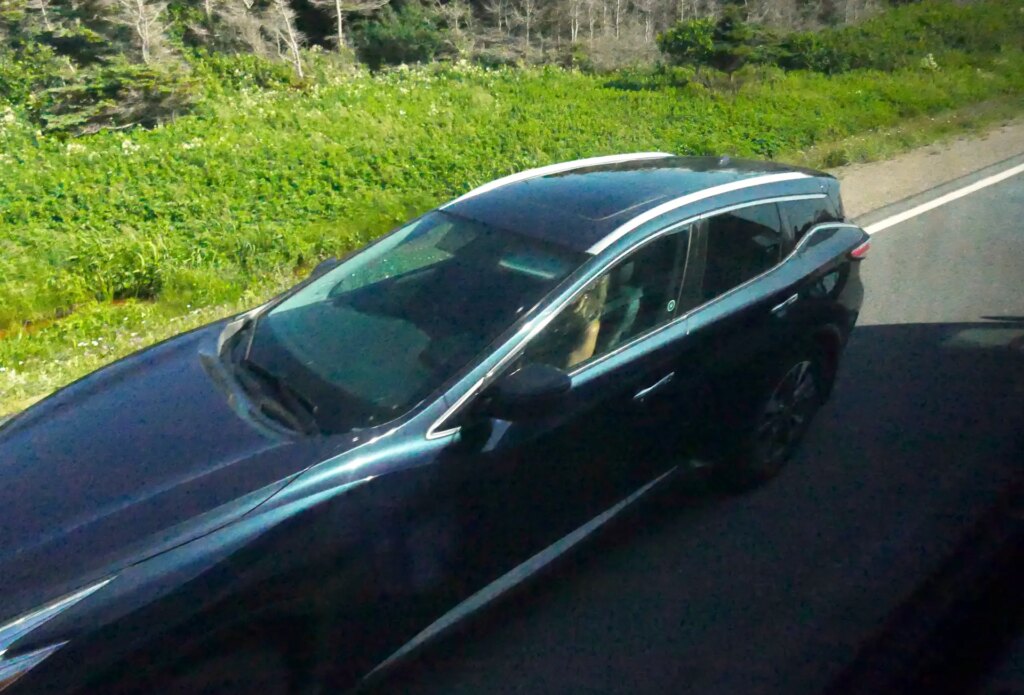
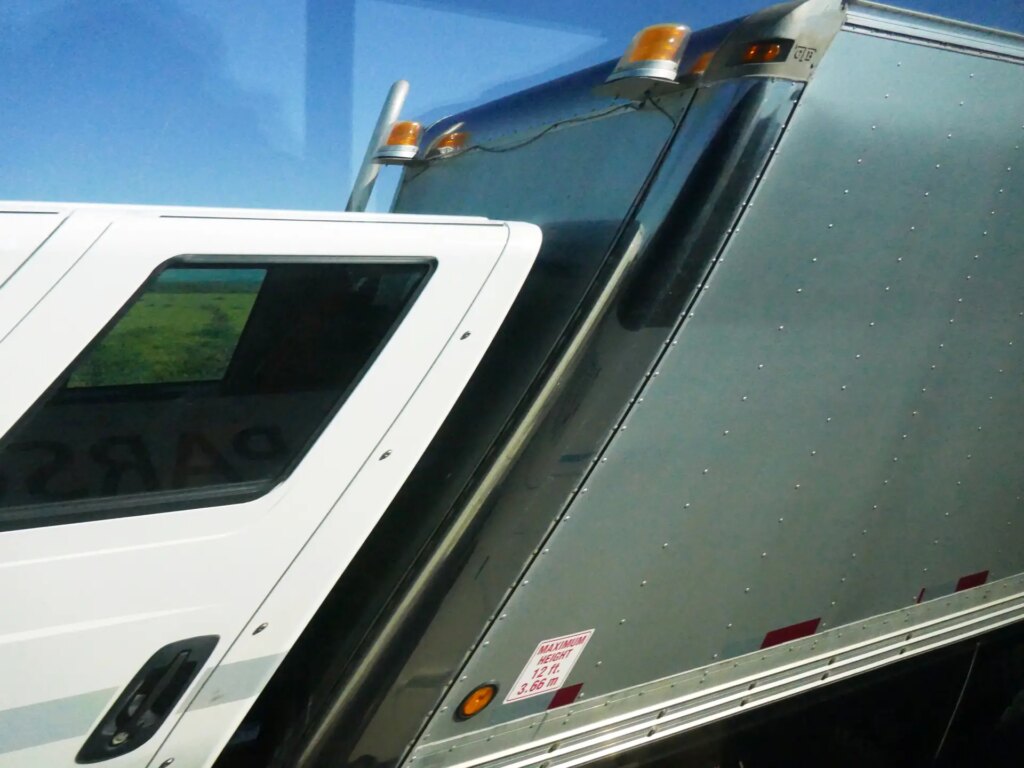
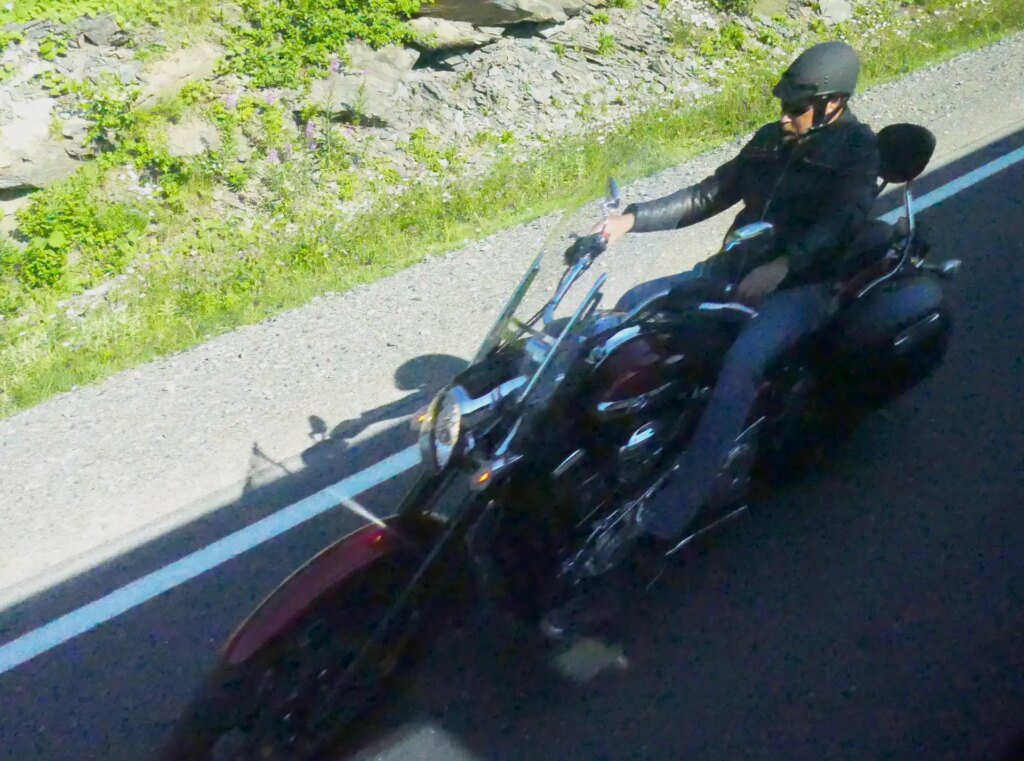
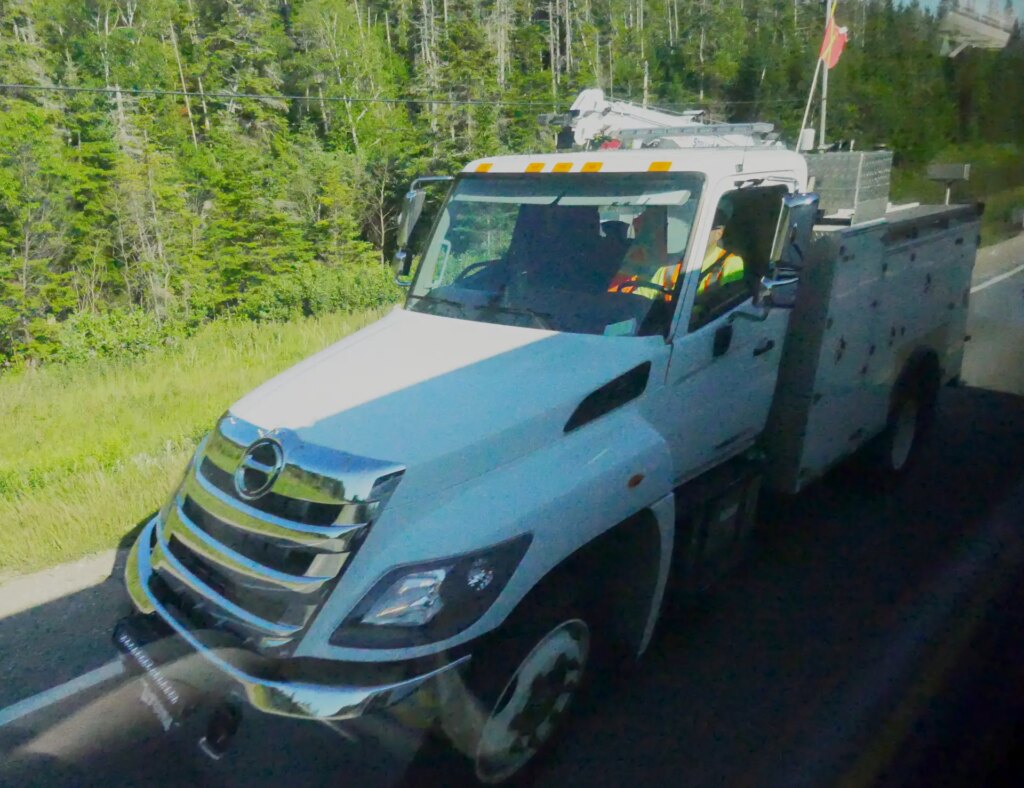
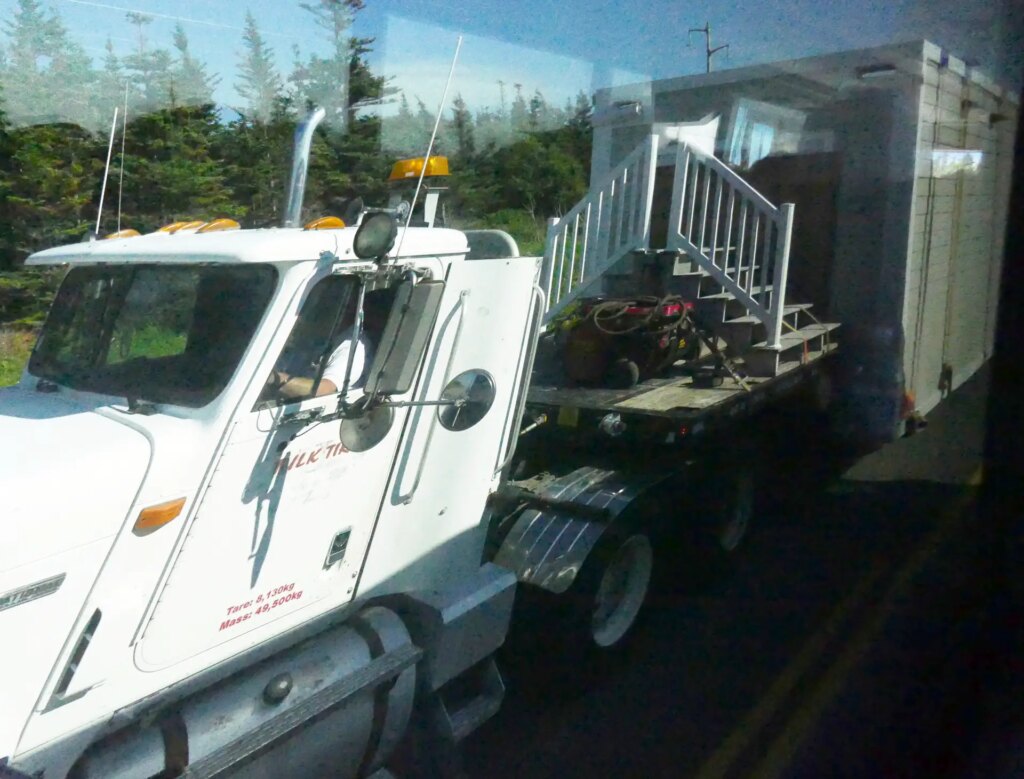
I grabbed these shots over the entire trip. It took many trials to optimize framing and image quality. And the files’ EXIF data indicates that they all were shot at shutter speeds from 1/16,000 to 1/5,000 sec, ISOs from 3200 to 6400, and with the lens always open to f/2.8. (I found that smaller apertures made the photos terribly dark and noisy.)
In future trips, I may try to capture different subjects– like trestle bridges– just outside my window. And the next time you’re in a bus over long stretches, give Rolling Shutter a try!
Danger…Danger…Will Robinson!
Though off-topic, I must share the following photo. A whole patch of this dangerously toxic plant was growing behind one of our motels… where anyone (including children) could touch it:

Despite appearances, it isn’t Queen Anne’s Lace. Called “Giant Hogweed,” it has meaty, jagged leaves; hairy, hollow stems (sometimes covered with purple-red stains); beefy flower clusters (up to 2 feet across); and heights of up to 15 feet. In Newfoundland, we saw it along roads, in parks, beside public walkways, and around hotels, restaurants and parking lots. It’s also invasive, drought resistant, and spreading in Europe, Canada and the U.S.
Do not touch or burn it (unless you know how to do so safely). And keep children and pets far away! According to the North Carolina Department of Agriculture, its sap causes a severe Photodermatitis skin reaction– with large, painful blisters and eruptions (much worse than poison ivy) within two days of contact. When exposed to sunlight, the blisters may leave permanent scars, and the plant’s sap can cause blindness if it touches the eyes.
Our Canadian tour guide didn’t know any of this… as we strolled by entire beds of the dangerous stuff. So we told them about a New England florist who had cut and gathered an armload of it for his arrangements, walked in the sun back to his shop, and ended up in the hospital with third-degree burns and permanent purple scarring of his hands, face, arms and chest.
If you happen to touch Giant Hogweed:
- Cover the contact area as much as possible,
- Return home immediately,
- Thoroughly wash the affected area with cold water and soap,
- Call your doctor, and
- Keep sunlight away from your skin (and hands away from your face) for two days.
Share this post:
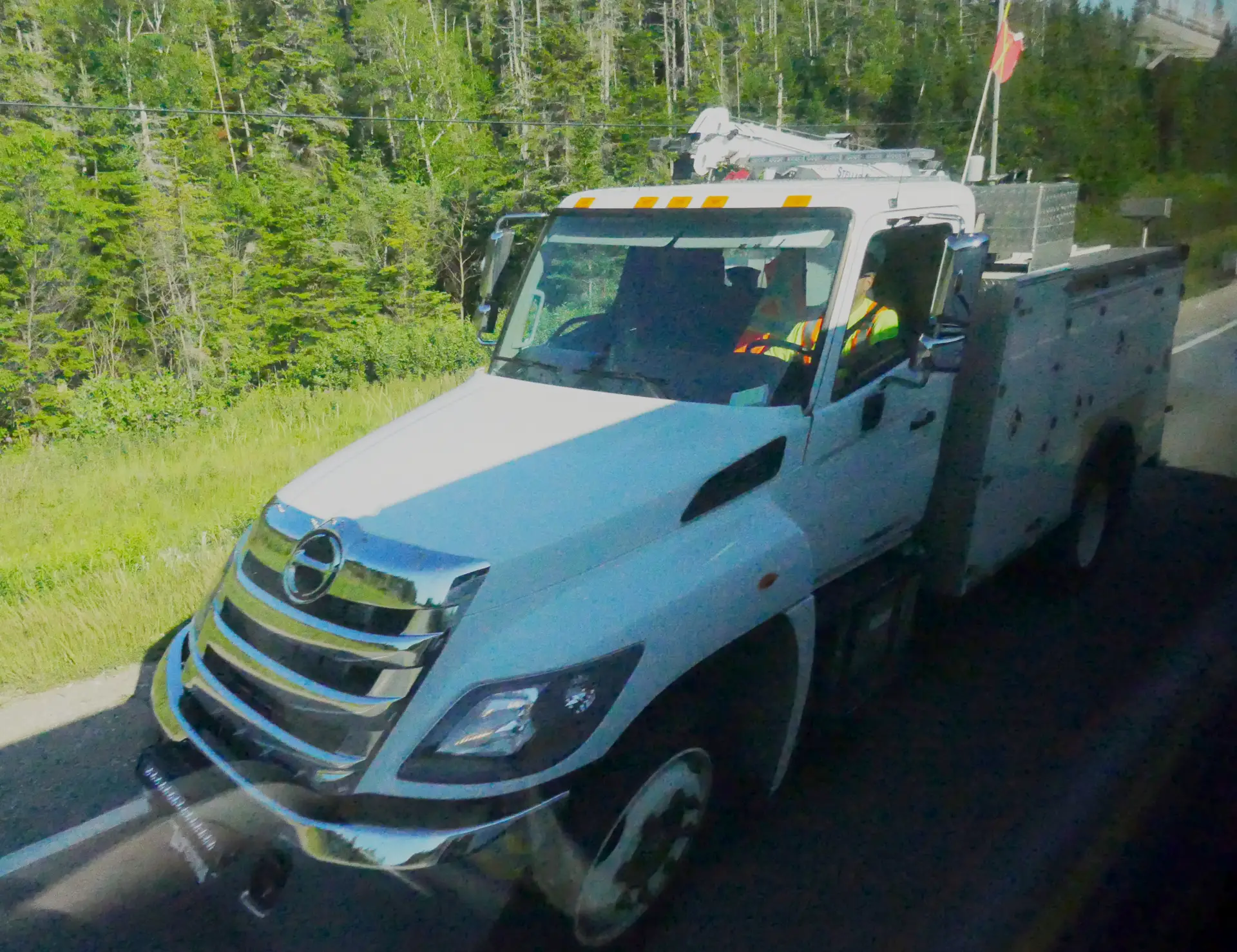








Comments
Roger on Some Rolling-Shutter Fun… From a Moving Bus – By Dave Powell
Comment posted: 24/09/2022
Also…
Thank you for the warnings & education on Giant Hogweed.
Why would the gods send us humans such dangerous plants?
Comment posted: 24/09/2022
Gary on Some Rolling-Shutter Fun… From a Moving Bus – By Dave Powell
Comment posted: 26/09/2022
Comment posted: 26/09/2022
Sroyon on Some Rolling-Shutter Fun… From a Moving Bus – By Dave Powell
Comment posted: 26/09/2022
Dave Powell on Some Rolling-Shutter Fun… From a Moving Bus – By Dave Powell
Comment posted: 26/09/2022
But I also just realized another digital benefit: the ability to choose whether to capture Rolling-Shutter or motion-blur effects... and possibly even both. (Must see if a longer electronic-shutter speed might capture both motion-blur AND Rolling-Shutter... for a real Speedy-Gonzales look!)
Comment posted: 26/09/2022
Dave Powell on Some Rolling-Shutter Fun… From a Moving Bus – By Dave Powell
Comment posted: 27/09/2022
Comment posted: 27/09/2022